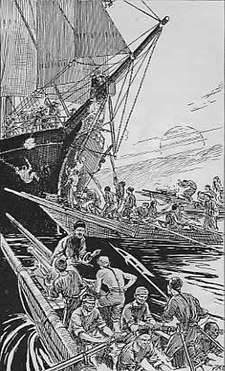
A junk is a type of Chinese sailing ship characterized by a central rudder, an overhanging flat transom, watertight bulkheads, and a flat-bottomed design. They are also characteristically built using iron nails and clamps. The term applies to many types of small coastal or river ships, usually serving as cargo ships, pleasure boats, or houseboats, but also going up in size up to large ocean-going vessels. There can be significant regional variations in the type of rig and the layout of the vessel.
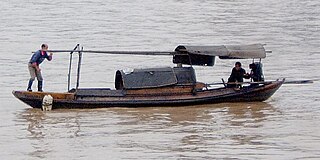
A sampan is a relatively flat-bottomed wooden boat found in East, Southeast, and South Asia. It is possibly of Chinese or Austronesian origin. Some sampans include a small shelter on board and may be used as a permanent habitation on inland waters. The design closely resembles Western hard chine boats like the scow or punt. Sampans are generally used for transportation in coastal areas or rivers and are often used as traditional fishing boats. It is unusual for a sampan to sail far from land, as they do not have the means to survive rough weather.

The East India Squadron, or East Indies Squadron, was a squadron of American ships that existed in the nineteenth century. It focused on protecting American interests in the Far East, while the Pacific Squadron concentrated on the western coasts of the Americas and the South Pacific Ocean. Its duties included the Yangtze River Patrol in China. The East India Squadron was established in 1835 and existed until it became part of the Asiatic Squadron in 1868.

Pedro Gilbert was a Spanish pirate, privateer and slave trader. At the time of his execution, he was one of the few remaining pirates continuing to raid shipping on the Atlantic coast.
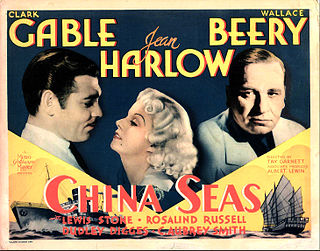
China Seas is a 1935 American adventure film starring Clark Gable as a brave sea captain, Jean Harlow as his brassy paramour, and Wallace Beery as a suspect character. The oceangoing epic also features Rosalind Russell, Lewis Stone, Akim Tamiroff, and Hattie McDaniel, while humorist Robert Benchley portrays a character reeling drunk from one end of the film to the other.

HMS Pearl was a Pearl-class 21-gun screw corvette of the Royal Navy launched in 1855, displacing 2,187 tons.

Shap-ng-tsai was a Chinese pirate active in the South China Sea from about 1845 to 1859. He was one of the two most notorious South China Sea pirates of the era, along with Chui A-poo. He commanded about 70 junks stationed at Dianbai, about 180 miles west of Hong Kong. Coastal villages and traders paid Shap-ng-tsai protection money so they would not be attacked. Chinese naval ships that pursued the pirate were captured and their officers taken captive and held for ransom. The Chinese government offered him a pardon and the rank of officer in the military at first he did not accept, but he eventually did so to avoid legal ramifications.

The Second Battle of Chuenpi was fought between British and Chinese forces in the Pearl River Delta, Guangdong province, China, on 7 January 1841 during the First Opium War. The British launched an amphibious attack at the Humen strait (Bogue), capturing the forts on the islands of Chuenpi and Taikoktow. Subsequent negotiations between British Plenipotentiary Charles Elliot and Chinese Imperial Commissioner Qishan resulted in the Convention of Chuenpi on 20 January. As one of the terms of the agreement, Elliot announced the cession of Hong Kong Island to the British Empire, after which the British took formal possession of the island on 26 January.

The Battle of Kowloon was a skirmish between British and Chinese vessels off the Kowloon Peninsula, China, on 4 September 1839, located in Hong Kong, although Kowloon was then part of the Guangdong province. The skirmish was the first armed conflict of the First Opium War and occurred when British boats opened fire on Chinese war junks enforcing a food sales embargo on the British community. The ban was ordered after a Chinese man died in a brawl with drunk British sailors at Tsim Sha Tsui. The Chinese authorities did not consider the punishment to be sufficient as meted out by British officials, so they suspended food supplies in an attempt to force the British to turn over the culprit.

The Battle of Ty-ho Bay was a significant naval engagement in 1855 involving the United Kingdom and United States against Chinese pirates. The action off Tai O, Hong Kong was to rescue captured merchant vessels, held by a fleet of armed war-junks. British and American forces defeated the pirates in one of the last major battles between Chinese pirate fleets and western navies. It was also one of the first joint operations undertaken by British and American forces.
Antelope was a medium clipper built in 1851 in Medford, near Boston, Massachusetts. She sailed in the San Francisco, China, and Far East trades, and was known for her fine finish work and for her crew's escape from pirates. She is often called Antelope of Boston to distinguish her from the extreme clipper Antelope of New York launched in 1852.

The Battle of the Leotung was a British victory against an overwhelming fleet of Chinese pirate ships. In 1855 the Royal Navy launched a series of operations into the Gulf of Leotung and surrounding area to suppress piracy, several battles were fought and hundreds of pirates were killed.

The Battle of Tonkin River was a major naval battle fought in northern Vietnam between the pirates of Shap Ng-tsai and the British Royal Navy with aid from the Qing Chinese navy and the Tonkinese. The 1849 expedition led to the destruction of Shap Ng-tsai's fleet and the loss of over 2,000 men. The battle occurred over a three-day period at the mouth of the Tonkin River, near present-day Hai Phong.

The Battle of Tysami was a military engagement involving a warship from the British China Squadron and the Chinese pirates of Chui A-poo. It was fought in September 1849 off Tysami, Harlaim Bay, China, and ended with a Royal Navy victory. It was also the precursor engagement to the larger Battle of Pinghoi Creek where Chui A-poo's fleet was destroyed.

Comet was an 1851 California clipper built by William H. Webb which sailed in the Australia trade and the tea trade. This extreme clipper was very fast. She had record passages on two different routes: New York City to San Francisco, and Liverpool to Hong Kong, and beat the famous clipper Flying Dutchman in an 1853 race around the Horn to San Francisco.
Admiral Sir Henry Smith was a British officer in the Royal Navy. He commanded the Aden Expedition in 1839 which took Aden as the first colonial acquisition of the reign of Queen Victoria. For this service he was appointed a Companion of the Order of the Bath. Smith was then sent to serve on the China Station, where he fired the first shot of the First Opium War at the Battle of Kowloon. He played an important role at the controversial Battle of Chuenpi later in the year, and as senior naval officer on the south coast of China fought the Battle of the Barrier. He later participated in the Battles of Second Chuenpi, the Bogue, and Canton, before forming part of the Amoy garrison after the Battle of Amoy. Having left China in 1843, he went on to command ships in the Mediterranean and then in the Baltic Sea during the Crimean War. Smith never served at sea again after obtaining flag rank in 1855 but became superintendent of the Royal Hospital Haslar and the Royal Clarence Yard. He was appointed a Knight Commander of the Order of the Bath in 1873, retiring in the same year.

The Battle off Mukah was a naval engagement fought in May 1862 between boats of the Sarawak and pirates. After the kidnapping of Sarawakian citizens some time before, two small gunboats encountered the pirates off Mukah on the northern coast of Borneo. In an unusual action, the Rajah Muda, Captain John Brooke, then the heir apparent to be White Rajah of Sarawak, led his force in the defeat of six pirate ships and the rescue of captured civilians.
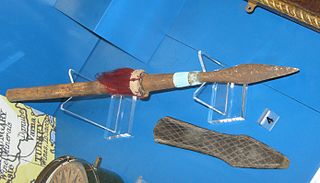
The Irene incident was a 1927 British anti-piracy operation in China. In an attempt to surprise the pirates of Bias Bay about sixty miles from British Hong Kong, Royal Navy submarines attacked the steamship SS Irene, of the China Merchants Steam Navigation Company, which had been taken over by the pirates on the night of 19 October. The British were successful in thwarting the hijacking though they sank the ship.

HMS Cleopatra was a 26-gun Vestal-class sixth-rate frigate of the Royal Navy. She was built at Pembroke Dock and launched on 28 April 1835. She was to have been launched in July 1834 and fitted thereafter. Her complement was 152 officers and men, 33 boys, and 25 marines. She was broken up in February 1862.
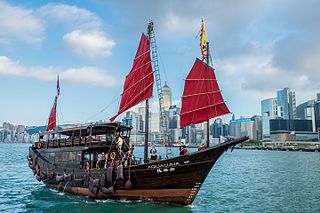
The Aqua Luna, known in Cantonese as the Cheung Po Tsai (張保仔), is a Chinese Junk operating in Victoria Harbour, Hong Kong. It was launched in 2006, and while it is named the Aqua Luna in English, in Cantonese it is named after the 19th-century Chinese pirate Cheung Po Tsai.
